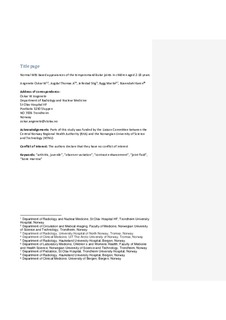| dc.contributor.author | Angenete, Oskar W | |
| dc.contributor.author | Augdal, Thomas Angell | |
| dc.contributor.author | Jellestad, Stig | |
| dc.contributor.author | Rygg, Marite | |
| dc.contributor.author | Rosendahl, Karen | |
| dc.date.accessioned | 2018-01-23T10:26:05Z | |
| dc.date.available | 2018-01-23T10:26:05Z | |
| dc.date.created | 2018-01-22T10:17:32Z | |
| dc.date.issued | 2017 | |
| dc.identifier.issn | 0301-0449 | |
| dc.identifier.uri | http://hdl.handle.net/11250/2478988 | |
| dc.description.abstract | Background
Knowledge of normal appearances of the temporomandibular joint (TMJ) is paramount when assessing the joint for disease in juvenile idiopathic arthritis. Reliable features defining normal TMJs in children are limited.
Objective
To establish reliable normal standards for the TMJ at magnetic resonance imaging (MRI).
Materials and methods
We included children and young adults aged 2–18 years undergoing a head MRI for reasons not believed to affect the TMJs. We assessed TMJ anatomy and contrast enhancement using a high-resolution 3-D T1-weighted sequence. We noted joint fluid and bone marrow oedema based on a T2-weighted sequence. Three experienced radiologists read all examinations twice in consensus and defined intraobserver consensus agreement.
Results
We evaluated the TMJs in 101 children and young adults (45 female), mean age 10.7 years (range 2–18 years). The intraobserver consensus agreement for the assessment of anterior condylar inclination in the sagittal/oblique plane was moderate to good (Cohen κ=0.7 for the right side). Cohen κ for intraobserver consensus agreement for condylar shape in the coronal plane on a 0–2 scale was 0.4 for the right and 0.6 for the left. Intraobserver agreement for measurement of joint space height and assessment of bone marrow oedema was poor. There was a statistically significant increase in anterior inclination by age in the sagittal plane on a 0–2 scale (P<0.0001). Eighty percent of the condyles showed a rounded shape in the coronal plane while 20% showed mild flattening. Thirty-five of 36 right TMJs showed contrast enhancement (mild enhancement in 32 joints, moderate in 3 joints).
Conclusion
Subjective assessment of the anterior condylar inclination in the sagittal/oblique plane and condylar flattening in the coronal plane can be considered precise features for describing TMJ anatomy in healthy children. There is an increasing anterior inclination by age. Mild contrast enhancement of the TMJs should be considered a normal finding. | nb_NO |
| dc.language.iso | eng | nb_NO |
| dc.publisher | Springer Verlag | nb_NO |
| dc.title | Normal MRI-based appearances of the temporomandibular joints in children aged 2-18 years | nb_NO |
| dc.type | Journal article | nb_NO |
| dc.description.version | submittedVersion | nb_NO |
| dc.source.journal | Pediatric Radiology | nb_NO |
| dc.identifier.doi | 10.1007/s00247-017-4048-x | |
| dc.identifier.cristin | 1548905 | |
| dc.description.localcode | This is a pre-print of an article published in [Pediatric Radiology]. The final authenticated version is available online at: https://link.springer.com/article/10.1007%2Fs00247-017-4048-x | nb_NO |
| cristin.unitcode | 194,65,25,0 | |
| cristin.unitcode | 194,65,15,0 | |
| cristin.unitname | Institutt for sirkulasjon og bildediagnostikk | |
| cristin.unitname | Institutt for klinisk og molekylær medisin | |
| cristin.ispublished | true | |
| cristin.fulltext | preprint | |
| cristin.qualitycode | 1 | |
